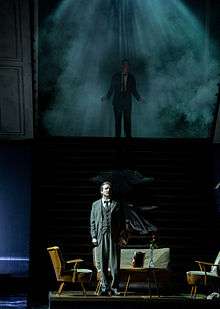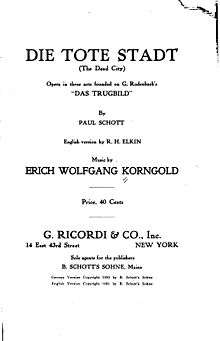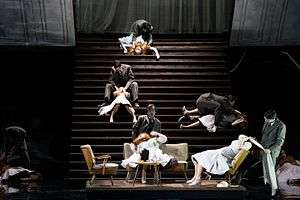Die tote Stadt
| Die tote Stadt | |
|---|---|
| Opera by Erich Wolfgang Korngold | |
 Scene at the Graz Opera in 2015 | |
| Librettist | |
| Language | German |
| Based on | Bruges-la-Morte by Georges Rodenbach |
| Premiere |
4 December 1920 |
Die tote Stadt (German for The Dead City) is an opera in three acts by Erich Wolfgang Korngold to a libretto by Paul Schott, a collective pseudonym for the composer and his father, Julius Korngold; it is based on the 1892 novel Bruges-la-Morte by Georges Rodenbach.
Origins
Rodenbach's novel Bruges la Morte had already been adapted by the author into a play. The play was translated into German by Siegfried Trebitsch under the title Die stille Stadt (The Silent City), which he later changed to Das Trugbild (The Mirage). Trebitsch was a friend of Korngold's father Julius. The two met in the street one day and got into a conversation about a possible operatic adaptation. Trebitsch later met Erich, who was enthusiastic about the project. Trebitsch recalled "[I] met the young master Erich Wolfgang Korngold in search of a scenario or, even better, a mood or operatic background that could be dramatically elaborated. I urged him to take up Das Trugbild."[1] Julius commented on the way the project evolved:
As soon as Erich read the play, he drafted a scenario for a one-acter, but Hans Müller urged him to get away from one-act operas and he sketched the first of three acts in prose. However, his work on two of his own plays prevented him from getting much further, and since his prose was wordy and unsingable anyway, we gladly excused him from the task.[1]
Father and son decided to adapt the play themselves, and co-wrote the libretto, using the pseudonym Paul Schott. Julius decided to change the plot so that the murder occurs in a dream, rather than in actuality, as in the original. Korngold started the composition in 1916. He left it for a year to take up military service before resuming and completing the score.[1]
Performance history

When Die tote Stadt had its premiere on December 4, 1920, Korngold was just 23 years old with two short one-act operas, Der Ring des Polykrates and Violanta, already to his name. The success of these earlier works was so great that Die tote Stadt was subject to a fierce competition among German theatres for the right to the world premiere. In the end, an unusual double premiere was arranged and the opera opened simultaneously at the Stadttheater Hamburg and Cologne (Glockengasse). In Cologne, the conductor was Otto Klemperer, and his wife Johanna Geisler sang Marietta. In Hamburg, Korngold himself was in the theatre, and the conductor was Egon Pollak. The opera's theme of overcoming the loss of a loved one resonated with contemporary audiences of the 1920s who had just come through the trauma and grief of World War I, and this undoubtedly fueled the work's popularity.
Die tote Stadt was one of the greatest hits of the 1920s. Within two years of its premiere it had circled the globe, including several performances at the Metropolitan Opera in New York City.
But the work was banned by the Nazi régime because of Korngold's Jewish ancestry and after World War II it fell into obscurity. The key postwar revivals of the piece were at the Vienna Volksoper (1967) and the New York City Opera (1975). In recent years, however, the work has enjoyed notable revivals, among others at the Theater Bonn, the Royal Opera House, the San Francisco Opera and at the Vienna State Opera.[2][3]
The French premiere of the opera took place in a concert performance in 1982 at the Paris Théâtre des Champs-Élysées. The first French staged performance was in April 2001 in Strasbourg under the baton of Jan Latham-Koenig with Torsten Kerl (Paul) and Angela Denoke (Marietta).
The opera received its UK premiere on 14 January 1996 in a concert performance by the Kensington Symphony Orchestra conducted by Russell Keable at the Queen Elizabeth Hall, with Ian Caley (Paul) and Christine Teare (Marie/Marietta). The first UK staged performance was on 27 January 2009 at the Royal Opera House, Covent Garden.
In Australia, the work was first premiered by Opera Australia on 30 June 2012 at the Sydney Opera House, with Cheryl Barker as Marie/Marietta, and Stefan Vinke as Paul, conducted by Christian Badea, directed by Bruce Beresford.[4] In 1986, he directed the episode "Glück das mir verblieb" of Aria.
In the 1989 film, Slaves of New York, directed by James Ivory, an excerpt from the 1975 RCA recording, with Carol Neblett, is heard.
Roles

| Role | Voice type | Premiere cast in Hamburg, 4 December 1920, (Conductor: Egon Pollak) |
Premiere cast in Cologne, 4 December 1920, (Conductor: Otto Klemperer) |
|---|---|---|---|
| Paul/Gaston/Victorin/Albert | tenor | Richard Schubert | Karl Schröder |
| Marie/Marietta | soprano | Annie Münchow | Joanna Klemperer |
| Juliette | soprano | Maria Jeritza | Joanna Klemperer |
| Brigitta/Lucienne | mezzo-soprano | Maria Olszewska | Katherina Rohr |
| Frank-Fritz | baritone | Josef Degler | Karl Renner |
| Chorus: party goers | |||
Synopsis
- Place: Bruges, Belgium
- Time: End of 19th century
Act 1
When the opera opens, Paul, a younger middle-class man whose young wife, Marie, has recently died, cannot come to terms with the sad reality of her death. He keeps a "Temple of Memories" in her honor, including paintings, photographs and a lock of her hair. When his friend Frank pays him a visit at his house and urges him to honor Marie by moving on with his life, Paul flies into a rant, and insists that Marie "still lives." He tells Frank that he has met a woman on the streets of Bruges who exactly resembles Marie (indeed, Paul thinks that it is Marie) and invited her back to his home.

Soon, the woman, Marietta, a young and beautiful dancer, appears for her rendezvous with Paul. They talk, she is put off by his odd behavior, but persists in trying to interest him in her charms—she sings (Lute Song, "Glück das mir verblieb") and dances seductively, but eventually gets bored and leaves. Paul meanwhile is driven to a state of extreme anxiety.
Torn between his loyalty to Marie and his interest in Marietta he collapses into a chair and begins to hallucinate. He sees Marie's ghost step out of her portrait and urge him not to forget her, but then the vision of Marie changes and tells Paul to go and move on with his life.
Act 2
After a series of visions in which his pursuit of Marietta alienates him from all his remaining friends, the act ends with Marietta finally overcoming his resistance and leading him offstage locked in a passionate embrace. All this takes place in Paul's imagination.
Act 3
Paul's vision continues. Back in his house, living with Marietta, he quarrels with her. She gets fed up with his quirks and continuing obsession with Marie and starts to taunt him by dancing seductively while stroking his dead wife's hair. In a rage, Paul grabs the lock of hair and strangles Marietta. Holding her dead body he exclaims "Now she is exactly like Marie." Then he snaps out of his dream. Astonished that Marietta's body is nowhere to be found, he has barely had time to collect his thoughts when his maid informs him that Marietta has come back to pick up her umbrella which she left in the house when she departed a few minutes ago. With the shock of the traumatic dream still fresh in his mind, Paul is met by his friends Brigitta and Frank who note that though Paul's vision is there, his desire is dead. Frank begins to leave and asks if Paul will leave, to which he replies, "I will try to". The opera ends with a reprise of "Glück, das mir verblieb" sung by Paul in what is apparently his last time in his "Temple of Memories".
Recordings
- 1924: Among historic recordings are three sides made for Odeon Records by Lotte Lehmann, Richard Tauber and George Szell soon after the Berlin premiere in April 1924. Maria Jeritza and Maria Nemeth, both involved in early performances of the opera, have also left recordings of the "Lute Song", while Karl Hammes and Richard Mayr, among the first to sing Fritz, recorded the Pierrotlied ("Mein Sehnen, mein Wähnen") from act 2.
- 1952: Munich release, available from Opera Today[5] which includes Maud Cunitz and Karl Friedrich, Fritz Lehmann conducting.
- 1975: RCA Victor, with Carol Neblett, René Kollo, Hermann Prey, and Benjamin Luxon, conducted by Erich Leinsdorf (RCA Victor CD #87767(2)). Recorded Bavarian Radio Concert Hall, Munich June 1975.
- 1983: Deutsche Oper Berlin, with James King, Karan Armstrong, and William Murray, conducted by Heinrich Hollreiser, and directed by Götz Friedrich (DVD: Arthaus Musik 101 656).
- 2001: Torsen Kerl, Angela Denoke and the Orchestre Philharmonique de Strasbourg conducted by Jan Latham Koenig. From The Opera National Du Rhin 2001. (DVD: Arthaus Musik 100 343).
- 2009: Sebastian Weigle and the Frankfurter Opern- und Museumsorchester recorded the opera live in November 2009 for Oehms Classics.
- 2009: Teatro La Fenice in Venice, with Stefan Vinke, Solveig Kringelborn, and Stephan Genz, conducted by Eliahu Inbal, staged and designed by Pier Luigi Pizzi (DVD: Dynamic 2013)
- 2010: Finnish National Opera, with Klaus Florian Vogt, Camilla Nylund, and Markus Eiche, conducted by Mikko Franck, staged by Kasper Holten, designed by Es Devlin (DVD: Opus Arte 2013). Same production performed at New National Theatre Tokyo (March 2014) with Torsten Kerl and Meagan Miller[6] (TV: NHK Premium Theater: 12 May 2014).
References
Notes
- 1 2 3 Carroll, Brendan G.; Pauly, Reinhard G., The Last Prodigy: A Biography of Erich Wolfgang Korngold, Amadeus Press, Portland, 1997, pp. 121–3.
- ↑ [http://operabase.com/oplist.cgi?from=01+01+2001&is=Die+tote+Stadt&sort=D List of performances of Die tote Stadt] on Operabase.
- ↑ Casaglia, Gherardo (2005).[http://www.amadeusonline.net/almanacco?r=&alm_testo=Die_tote_Stadt "Die tote Stadt"]. Almanacco Amadeus (Italian).
- ↑ "No forgotten masterpiece but this city is worth a visit" by Peter McCallum, The Sydney Morning Herald, 2 July 2012
- ↑ Die tote Stadt, Opera Today site with synopsis and MP3 recording (there it is said to be a live performance, but no trace of auditorium noise or applause can be heard)
- ↑ http://www.nntt.jac.go.jp/opera/dietotestadt/
Sources
- Palmer, Christopher, "Erich Wolfgang Korngold", Die tote Stadt, Grove Music Online ed. L. Macy (Opera) (Accessed May 4, 2007) (subscription required)
External links
| Wikimedia Commons has media related to Die tote Stadt. |
- Die tote Stadt: Scores at the International Music Score Library Project
- German/English libretto at Wikimedia Commons
- Korngold Society's synopsis
- Die tote Stadt, Details, Schott Music
- Die tote Stadt TV 1983 at the Internet Movie Database, directed by Brian Large